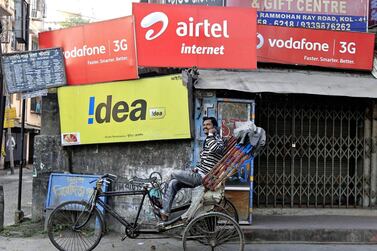Indian online shopping giant Flipkart, the country's home-grown answer to Amazon, announced plans this month to start producing original shows for its new video streaming service.
With plans in place for shows featuring Bollywood stars to short features, the move aims to tap into the country's growing video streaming market. It also brings Flipkart, now majority-owned by Walmart following a $16 billion (Dh58.77bn) deal last year, head-to-head with Amazon's Prime Video streaming service.
“We saw an opportunity to create great video content which is easier for people to consume, that is mobile-first,” says Prakash Sikaria, vice president of growth and monetisation at Flipkart.
Consumption of online content in India is surging.
India’s video streaming market is expected to grow 21.8 per cent a year to reach 119.76bn rupees (Dh6.2bn) by 2023, up from 44.64bn rupees last year, according to a report by accountancy firm PwC.
Many companies are already competing for their share of eyeballs in the market. Netflix is actively expanding in India, while there are local platforms including Hotstar that are continuing to grow.
As these platforms scale up, PwC's research highlights that India's video streaming market is set to overtake that of South Korea to become the eighth-biggest market in the world by 2023.
“India is the fastest growing entertainment and media market globally and is expected to keep that momentum,” says Rajib Basu, partner and leader of PWC India's entertainment and media arm. “Our research shows that in the next five years India will see significant growth in [video streaming],” he says.
The insatiable appetite for online video streaming in India is being driven by growing smartphone ownership, spurred by cheaper devices and rock-bottom data costs.
Indians consume the most data per month globally, at an average of 9.8GB, which is expected to almost double to 18GB per month by 2024 due to “attractive data plans being offered by service providers and young people's changing video viewing habits”, according to a report by Swedish telecom firm Ericsson. Once 5G launches in India, that will also help to propel this trend.
For most internet users in India, their smartphone is their primary or only means of getting online.
That's why Netflix in July rolled out a mobile-only subscription option in India. It is the first country in which Netflix has launched such a plan. Priced at 199 rupees a month, it costs less than half of the price of its regular basic plan in India.
A Netflix spokesman, in an emailed statement, says that this step “is a great example of how important India is to Netflix”.
“The plan has exceeded our expectations,” a Netflix spokesman says. “This positive response from our Indian members allows us to invest more in Indian content.”
Investing in producing original programmes that appeal to the local audience is key to the company's continued growth in the market.
Since its launch in India in January 2016 it has more than doubled its catalogue, and is creating more and more original films and series for the country. It has announced 16 original series in India, of which eight have launched, and 24 original films, of which nine have launched.
Its first Indian original series, a gritty crime thriller called Sacred Games, became a popular success and was critically acclaimed.
“India is one of the world's great creative centres and in a golden age of entertainment,” the spokesman says.
“Our focus is to make the content offering in India so good that more and more Indians find it of great value. This means creating original series and films in India and adding top quality and big budget licensed content.”
The focus on India comes as Netflix is experiencing slowing growth in the US. The platform added 2.1 million subscribers in the US in the first nine months of this year compared to 4.1 million in the same period last year, according to its latest financial report. Third quarter revenue, however, rose 31 per cent on the previous year to $5.2bn, with growth in international subscriptions helping to boost business, the company's accounts show.
Research firm IHS Markit estimates that Netflix is set to almost triple its user numbers in India this year to 4.1 million.
Neeraj Roy is the founder and chief executive of Mumbai-based Hungama Digital Media, which has a video service that it launched in 2015, including its own original programmes that it has started rolling out over the past year and-a-half. These include Damaged, a psychological crime drama about a female serial killer, and Bar Code, a drama about two friends in the nightclub business in Mumbai.
“We felt there was a need for more contemporary programming in India,” says Mr Roy.

He explains that there are about 18 major video streaming services in India, including Flipkart's new service. But he says there's enormous scope for growth in the video streaming market given the country's population of more than 1.3 billion and its diversity of languages and cultures, with hundreds of millions more people expected to move online over the coming years.
“It's not a winner takes all market in India,” he says. “I believe the India market will always have more players than other markets.”
Succeeding in the sector does require significant investment, however. Because of this, Mr Roy says profitability for video streaming platforms at this stage in India is a challenge.
“The two basic costs for these services is content and marketing and distribution,” Mr Roy says. “How do you get your service lit up and consistently seen by a variety of consumers?”
But he adds that over the next three to four years, he expects “a consistent rise in monetisation” in India.
Nagesh Banga, the deputy country manager, at live-streaming platform Bigo Live, says that there are ample opportunities in the video streaming sector in India, not only in terms of entertainment content, but also educational programming. And not all content requires major investment.
“Users and creators have ample opportunities to earn money while showcasing their talent without any formal technical knowledge or know-how of video creation, says Mr Banga. “This way, not only the professional content is driving the user base, but user-generated content is also creating a diverse pool of content for online consumption.”
China's TikTok, which allows users to post their own short videos, has become a huge phenomenon in India.
Mr Banga adds that “every sector has its own set of challenges, and video streaming sector comes with a challenge of retaining the user base. The Indian market is flooded with apps and platforms offering services”.
Something this is proving to be an issue for video streaming platforms in India, however, is the threat of censorship.
Reuters on Friday reported that India was considering potential censorship of content of streaming services such as Netflix and Amazon, following court cases in which complainants have argued that certain content has been obscene or hurt religious sentiment.

Netflix's Sacred Games faced a challenge in court last year over scenes that were said to be offensive and allegations of insults against the former Indian Prime Minister Rajiv Gandhi. The case was eventually dismissed.
In January, Netflix and Indian rival Hotstar decided to sign a self-regulation code, but Amazon opted not to sign.
“I think what is likely to happen is that there will be a mutual understanding and acceptance between the various platforms and creators that these are the guidelines that we'd like to work on,” says Mr Roy. “Not censorship.”
As the market continues to grow in India, the story of video streaming services is still unfolding.







